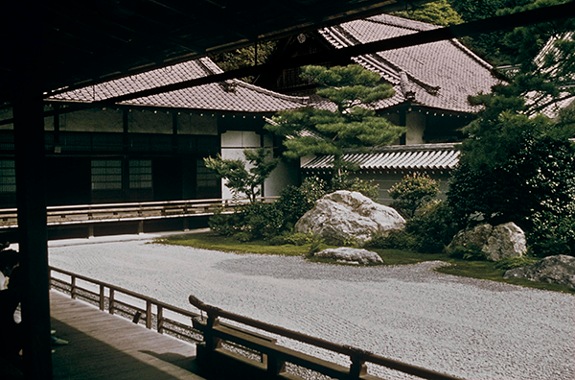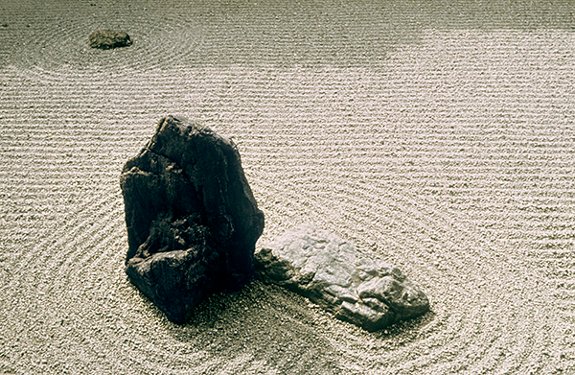World Landscape Architecture Month: Nanzen-ji
The landscaping and gardens at Nanzen-ji certainly could be considered an outdoor sculptural installation. As landscape architecture, the garden of this extraordinarily peaceful place in Kyoto approaches the visual aesthetic of a traditional Japanese or Chinese monochromatic landscape.
 |
| Kobori Enshū (garden designer) (1579–1647, Japan), Leaping Tiger Garden, Nanzen-ji, Kyoto, Japan, garden ca. 1628–1630, temple dedicated 1291. Image © 2022 Davis Art Images. (8S-10283) |
Nanzen-ji, like many temples, was formerly an aristocratic estate. It was originally built as a villa for Emperor Gosaga (1220–1272) in 1264. After Emperor Kameyama (1249–1305) retired as a cloistered emperor, he converted it into a Buddhist temple in 1291. Over time it became one of the five great Zen temples of Kyoto. The original temple buildings were destroyed by fire numerous times, including during the Ōnin War (1467–1477). Some of the buildings were rebuilt in the 1500s.
Attached to the Abbot's Quarters (Hojo) is the Leaping Tiger Garden. It was designed by Kobori Enshū, a feudal aristocrat who was skilled in waka poetry, calligraphy, ceramics, architecture, and most importantly, the tea ceremony. Gardens of sand, gravel, and rocks were meant entirely for contemplation. In the spirit of Zen simplicity, such gardens reflect the essence of black-and-white landscapes painted in ink. The raked sand and stones represent water, while the larger rocks represent mountains. The garden is meant to be viewed from various sides, a sort of landscape painting in the round.
Kobori’s landscaping aesthetic was known as kirei sabi, elegant simplicity. He maintained the simplicity of wabi sabi, the Zen ideal of transience and imperfection. His garden style incorporated a more objective beauty to the sense of simplicity and incompleteness.
During the Kamakura Period (1185–1333), Japan’s so-called medieval period, the provincial military families fought one another for control of the country. The Gempei Wars (1185–1192) witnessed the victory of the samurai-supported clans over the emperor’s court, and the institution of the shogunate, a military dictatorship that would rule Japan until the 1800s. The respected emperor no longer had any real power. During the Muromachi Period (1392–1573), samurai families cemented their power over Japan.
From the Kamakura to the Muromachi Periods, Zen Buddhism took a strong hold in Japanese religion. It was particularly favored by the samurai class because they lived without fear of death and acted spontaneously and intuitively. One of the overriding themes in Zen Buddhism is the experience of enlightenment when one least expects it. Meditation on the simple things in life encouraged preparing one for such an experience.
Zen Buddhism had a great influence on architecture from the Kamakura through the Edo Period (1603–1867). The elaborate, overdecorated style of Chinese temple architecture was rapidly overtaken by the influence of earlier simple, light, and serene Japanese styles. The only Chinese influence seen in this temple is the tile roof. A significant part of temples from the Kamakura Period until the 1800s was the emphasis on contemplation—of gardens, landscape, and the moon—and with the tea ceremony. The garden was an integral part of temple architecture.
Kobori, born Kobori Masakazu in Nagahama (Shiga prefecture), was named a feudal lord by Tokugawa Iyeasu (1543–1616), the “founder” of the shogunate during the Edo Period. Kobori was also a tea master, master architect, and garden designer. He was considered the greatest tea master of his generation, thought to having hosted more than 400 tea ceremonies. He also designed ceramic wares and pavilions dedicated to the tea ceremony. Besides all that, he was also a calligrapher and a poet. In 1606, Kobori was named sakuji bugyō by Iyeasu, which means official in charge of architectural and construction affairs. He built or renovated countless castles, gardens, tea houses, and palaces during his lifetime.
 |
| Kobori Enshū, Islands in the wavy sea, Leaping Tiger Garden, Nanzen-ji, Kyoto, Japan, garden ca. 1628–1630, temple dedicated 1291. Image © 2022 Davis Art Images. (8S-10284) |


Comments